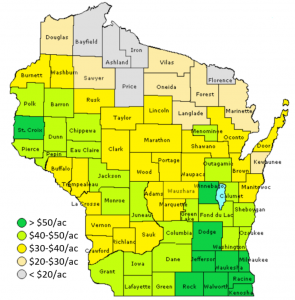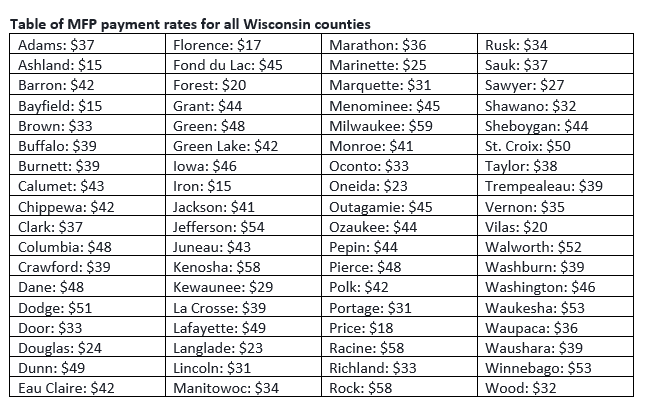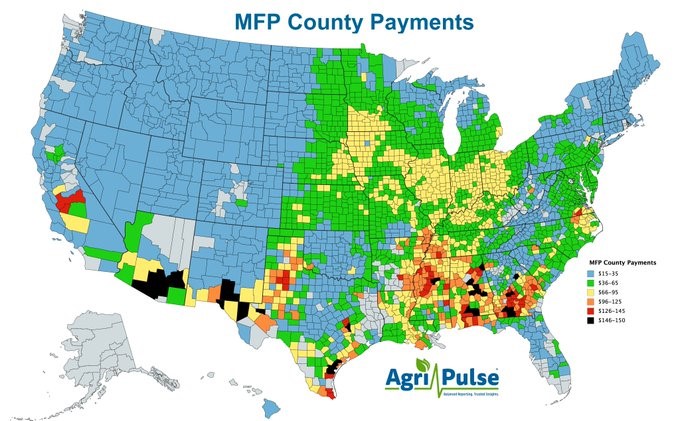Paul D. Mitchell, Agricultural and Applied Economics, UW-Madison
Office: (608) 265-6514 Email: pdmitchell@wisc.edu
Want a printable version? Click HERE
The 2019 trade assistance package for farmers was announced last week to help producers whose commodities have been directly impacted by tariffs from our on-going trade wars. The total program cost is $16 billion, with $14.5 billion dedicated to Market Facilitation Program (MFP) payments and the remainder for commodity purchases and agricultural trade promotion.
How it Works
MFP is run by the USDA-Farm Service Agency (FSA), so farmers go to their county FSA office to apply. In short, farmers simply add up the acres of eligible crops they planted in a county in 2019 and then multiply this acreage by the payment rate ($/ac) for their county. Several typical Wisconsin crops are eligible, including corn, soybeans, wheat and alfalfa hay, as well as oats and other small grains, as well as dry beans and dry peas. See the FSA links for the full list. Crop farmers should contact their county FSA office to clarify details and to apply.
Prevented Planting
The 2018 MFP program made payments based on production, not acreage. The USDA noted their plan to pay based on acreage this time around, but did not hint at how they would treat prevented plant acres. This has now been clarified – farmers who filed prevented plant claims for their crop insurance and planted a cover crop by August 1st are eligible for a $15/acre MFP payment for those acres.
Dairy and Wisconsin Specialty Crops
Dairy producers will receive $0.20/cwt based on historical production. Based on the state average milk production per cow, MFP dairy payments in Wisconsin will average about $50 per cow, and if all dairy farmers apply, this would total more than $60 million for the state’s dairy farmers. Cranberries and cultivated ginseng are also eligible commodities, with payments of $3/cwt for cranberries and $2.85/lb for ginseng. Based on these payment rates and typical acreage in the state, these imply not quite $3 million for cranberry growers and more than $5 million for ginseng growers, both of whom have seen their export dominated markets hit hard by tariffs. Dairy farmers and cranberry and ginseng growers should also contact their county FSA office to clarify the details and apply.
MFP Payment Rates
Wisconsin MFP payment rates range from $15/ac in Ashland, Bayfield, and Iron Counties to $59/ac in Milwaukee County. The full list is in the Table, while this map summarizes the Wisconsin rates. 

Payment rates follow the general trend of decreasing yields as one moves north, but it remains unclear why Milwaukee County has a payment rate of $59/ac, the highest in the state, and why the other counties in the southeastern corner are higher than those elsewhere. Nationally, the same issue appears, based on this map from AgriPulse. Not surprisingly, payment rates in the heart of the Corn Belt are higher than in Wisconsin and other areas. However, we also see several counties in the Southern US with payment rates ranging $146/ac to $150/ac. The AgriPulse article attributes these high payment rates to counties dominated by cotton and sorghum production, two crops with prices also hit hard by tariffs. A quick look at the USDA-NASS data from the 2017 Ag Census for many of these counties gives a story like Milwaukee County, WI – high payment rates with little crop production in the county. Much of the mystery surrounding the logic for these rates would be eliminated if the USDA released the methods used, as is the case for other FSA subsidy programs such as ARC and PLC and crop insurance premiums. Others have also noted this issue as well. Transparency would build confidence in the process and a belief in its fairness among farmers and the public in general.

This MFP payment will be the first part of up to three, with signup for the 2nd and 3rd parts beginning in November and January if market conditions warrant. Farmers should sign up for these MFP payments and use them to improve the financial situation of their farms in this tough time. Those feeling that they do not need or deserve MFP payments may want to consider taking them anyway and then donating the money to some of the charitable organizations in their communities making positive impacts.
Additional Resources
- Official USDA web page for the MFP: https://www.farmers.gov/manage/mfp
- USDA list of all MFP county payment rates: https://www.farmers.gov/sites/default/files/documents/PaymentRates.pdf
- Interview with Paul Mitchell on Wisconsin Public Radio: https://www.wpr.org/southeastern-wisconsin-counties-come-out-top-2019-tariff-aid-payments
Contact us: renk@aae.wisc.edu
